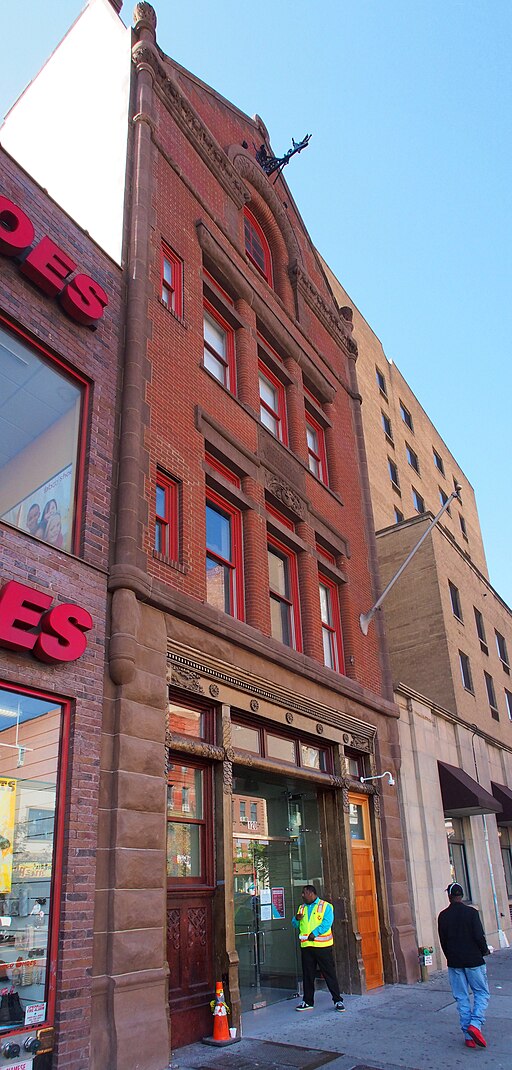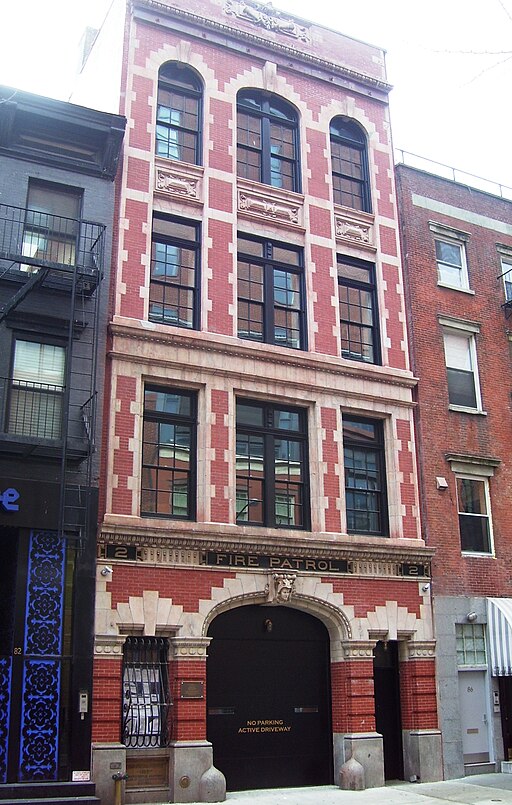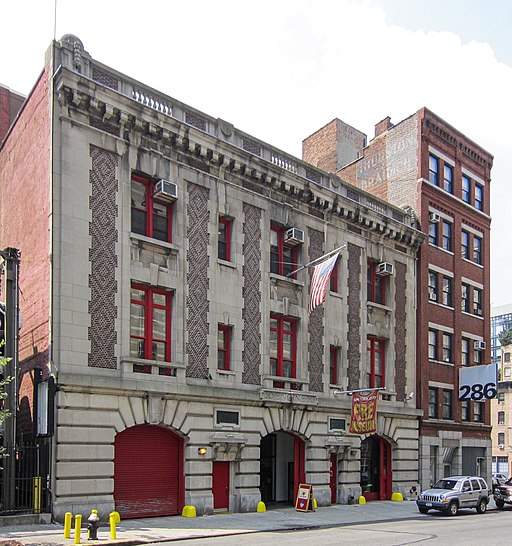|
By Laurie Lewis Among the very old buildings in New York City are some firehouses dating from the mid- and late-1800s and early 1900s. These structures were built large enough to house the horses that pulled the equipment, the men who fought the fires, and their equipment and supplies. Some decommissioned firehouses have been renovated as educational, social service, or cultural centers, whereas others have been converted for private use. This newsletter showcases seven repurposed Manhattan firehouses. Originally: Engine Company 31 Now: Downtown Community Television Center One of the most architecturally distinct repurposed firehouses is Engine Company 31. Straddling the border of Tribeca and Chinatown, at 87 Lafayette Street, the structure dates back to 1895. The designer was Napoleon LeBrun, who served as the official architect of the Fire Department of New York (FDNY) from 1879 to 1895. The inspiration for this firehouse was a sixteenth-century chateau in France’s Loire Valley. The historic firehouse was one of the first buildings to be named a landmark by the New York City Landmarks Preservation Commission. Six years later, in 1972, the FDNY decommissioned the firehouse. The same year marks the founding of the current occupant of the former firehouse, the Downtown Community Television Center. The nonprofit organization offers education and resources to aspiring documentary filmmakers. Originally: Engine Company 15 Now: Dale Jones Burch Neighborhood Center of the Henry Street Settlement The firehouse is at the right of the Henry Street Settlement buildings. Another former firehouse associated with a nonprofit organization is Engine Company 15, located adjacent to and now part of the Henry Street Settlement on the Lower East Side. This is another Napoleon LeBrun creation, dating from 1884. The architect blended the firehouse with the neighboring red-brick, Federal-style homes that would soon become the Henry Street Settlement. Engine Company 15 remained in the Henry Street firehouse for almost 120 years. In 2017, the Henry Street Settlement bought the vacated building from the city for an unbelievable sum: only $1. Two years later the Dale Jones Burch Neighborhood Center opened in the former firehouse. It offers an array of social services, including free legal and financial counseling, access to food stamps and affordable health insurance, and online programming for parents. Originally: Fire Hook & Ladder Company 14 Then: Engine Company 36 Now: Caribbean Cultural Center African Diaspora Institute A decommissioned firehouse in Harlem has a similar story. The city sold a late nineteenth-century firehouse designed by LeBrun’s firm to a nonprofit organization for $1. This building, located at 120 East 125th Street, is architecturally typical of LeBrun’s midblock firehouses. Built for Fire Hook & Ladder Company 14 in 1889, the facility became the home of Engine Company 36 in 1975. It was designated a landmark in 1997. Five years later, the firehouse was decommissioned. The current occupant of the former Harlem firehouse is the Caribbean Cultural Center African Diaspora Institute (CCCADI). Begun in 1976, the CCCADI moved into this location in 2016. Although it paid only $1 for the structure, it spent more than $9 million renovating the building to serve as an exhibition and performance space and education center focusing on Caribbean culture with African roots. Originally: Hook & Ladder Company 40 Then: Faison Firehouse Theater Now: For sale Another Harlem firehouse, built after LeBrun’s tenure as architect for the FDNY, is the work of Howard Constable. Hook & Ladder Company 40 moved into the new building on the first day of 1910. The structure accommodated one horse-drawn firetruck but was too small for the equipment of firefighters late in the twentieth century. Award-winning choreographer George Faison bought the abandoned building at 6 Hancock Place in 1999. After extensive renovations, it reopened in 2007 as the Faison Firehouse Theater. In addition to the theater, the repurposed building has a dance studio, offices, and living space. Late last year, Faison decided to sell the property. It is being marketed as a package with the adjacent vacant lot for about $10 million. Originally: Hook & Ladder Company 13 Then: Andy Warhol studio; Daniel Wildenstein gallery Now: Private office A decommissioned firehouse on the Upper East Side also has ties to the arts. Hook & Ladder Company 13 dates all the way back to 1868, just three years after establishment of New York City’s professional fire department. (Previously, firefighters were unpaid volunteers.) The building, at 159 East 87th Street, remained the home of Company 13 for almost 100 years. In 1962, a neighborhood resident rented the abandoned firehouse for $150 a month for use as a studio. The artist: Andy Warhol. He stayed in the decrepit, leaky building only a few months, but that was long enough to seal the reputation of the address as Andy Warhol’s first studio. Art dealer Daniel Wildenstein bought the old firehouse in 1965 and transformed the space into a sculpture garden and art gallery. The property remained in the Wildenstein family until 2016, when it sold for almost $10 million. Once red but now a modest gray, the two-story building has been converted into rental apartments and most recently a private office. Originally: Fire Patrol 2 Now: Anderson Cooper’s home Greenwich Village also boasts a former firehouse with a celebrity connection. Architect Franklin Baylis designed the 1906 building, at 84 West 3rd Street, to house Fire Patrol 2. Fire patrols, which harken back to the days of the volunteer fire department, focused mainly on protecting property rather than people and were operated by the New York Board of Fire Underwriters rather than the FDNY. After the Fire Patrol was disbanded in 2006, its last three firehouses were put up for sale. In 2010, CNN newsman Anderson Cooper purchased the Greenwich Village building for $4.3 million. In making it his home, he kept certain features from the firehouse days, including the pole and spiral staircase that the original tenants used. The home has all the modern conveniences, with some historic touches. For example, the gym contains the type of equipment that the firemen would have used to keep fit for their demanding job. Originally: Engine Company 30 Now: New York City Fire Museum In 1904, Engine Company 30 moved up the street from its original home to a new Beaux-Arts building. The large firehouse, at 278 Spring Street, was the work of architect Edward P. Casey. Engine Company 30 remained there until the unit was eliminated as a cost-saving measure in 1959. Today the building serves as the New York City Fire Museum. The museum was already more than a century old when it settled into this decommissioned firehouse in 1987. If this newsletter has whet your appetite for more information about FDNY history, pay a visit to the museum. It is open Wednesday through Sunday, 10 to 5.
Tours We are no longer scheduling public tours that are open to anyone, but we are available for private tours. If you would like ideas for private tours, please see the Tours page of this website. |
Archives
April 2024
|









